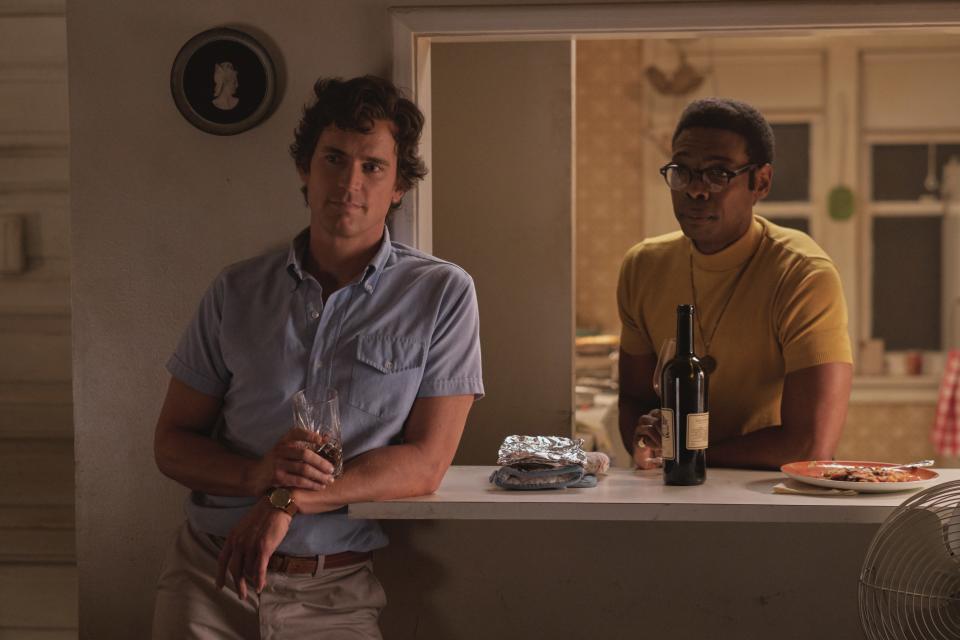Netflix’s The Boys in the Band Is a Tough Watch—But I Couldn’t Look Away
I'm a bad gay. I’ve always known about The Boys in the Band—an iconic 1968 play about gay men by Mart Crowley—but I’ve never seen it. Not the 1970 film version, directed by William Friedkin. Not the 2018 Broadway revival, which happened right under my nose. Not anything. The plot always intrigued me: A group of gay men gather for a birthday party, but the evening is thwarted by a surprise guest.
That bare bones description sounds like many kikis I’ve had with my own friends—and as I sat down to watch the Netflix adaption, now streaming, I realized just how right I was. And wrong. The Boys in the Band—this version, at least—is both a relic of gay men’s painful past and an even more painful portrait of what hasn’t changed.
The men in this story have some privilege, even as gays in the ’60s, because they live in progressive New York City. But they’re all battling demons that flare up as the evening unfolds. We have Michael (Jim Parsons), the party host, a lapsed Catholic who numbs his gay guilt with booze and shopping. Harold (Zachary Quinto), the birthday boy, grapples with his “old age” and “dwindling looks.” Donald (Matt Bomer) is seeing a therapist, presumably about his homosexuality. And Larry (Andrew Rannells) and Hank (Tuc Watkins), a couple, argue constantly over their different views on monogamy.

We also have Emory (Robin de Jesús), who’s overtly feminine and criticized by his friends for it, and Bernard (Michael Benjamin Washington), the sole Black character, who’s the target of racist remarks—mostly from, confusingly, the only other nonwhite character: Emory. Then there’s Alan (Brian Hutchison), Michael’s straight friend from college who arrives unexpectedly, shifting the tone of the night. He and Michael were supposed to have lunch the next day to discuss an urgent problem Alan is having, but he shows up to the party instead. Said “urgent problem” is never actually revealed.
But you can probably guess it. The narrative of The Boys in the Band is fueled by gay shame. These men spend the majority of their time together eviscerating each other for having too much (or not enough) sex, for being too feminine, for being too broke or too drunk or too…anything. The vitriol is palpable, especially as the drinks flow, and by the end it’s downright suffocating. Aren’t these guys supposed to be friends? I found myself asking at multiple points. Or are they thrown together by circumstance? The circumstance of being gay and navigating a world where they can’t be their true selves?
I’m inclined to think the latter. Maybe that’s why Alan crashes the party: because he too is gay and is grappling with what it means. That’s open to interpretation, but what is certain is that the self-loathing in this movie is uncomfortably, unflinchingly present. I felt a small modicum of this growing up in the South, but thankfully the world is much different now than it was in the ’60s. Pop culture phenomenons like Glee and Gaga helped forced our culture out of the Stone Age and lead it to embrace LGBTQIA+ people, at least on a mainstream level. Gay marriage is legal nationwide (for now—please go vote). Queer people don’t have to skulk in the shadows as much as they once did.
It’d be naive to think that’s completely gone, though. I’ve been lucky to have an accepting family and live in a progressive area, but this isn’t the case for all queer people. For those in more conservative towns, like the one I grew up in, code switching and “de-feminize-ing” is necessary for survival. I felt this even four hours north of New York City, where I quarantined for a month. Wearing a Charli XCX T-shirt in public felt like a radical act—like I was making out with a man in broad daylight 60 years ago. It was terrifying and, I’m sure, a glimpse of what the men in Boys in the Band felt daily. That type of constant fear doesn’t breed actual friendships: It breeds, well, what we see the men do to each other in this movie. They’re frenemies at best, bound by a sinister, internalized homophobia that many gay men grapple with even today.
But the world is different now. I think most queer friend groups today are grounded in pride, not pain. When demons like the ones The Boys in the Band highlights present themselves, my gay friends help me fight them; they don’t exacerbate them. The obsession with getting older, with gaining weight, with losing our hair, our muscles, our sex appeal—these are things gay men still talk about constantly today, and I wish we didn’t.
In that respect, the last line of The Boys in the Band isn’t all that dated: “Show me a happy homosexual, and I’ll show you a gay corpse.” Maybe society isn’t contributing to gay men’s unhappiness as much as it once was, but gay men themselves are. Let’s fight our demons together.
The Boys in the Band is now streaming on Netflix.
Christopher Rosa is the staff entertainment writer at Glamour. Follow him on Twitter @chrisrosa92.
Originally Appeared on Glamour


